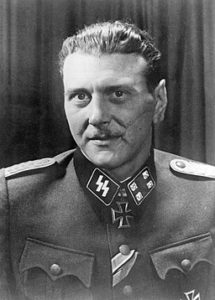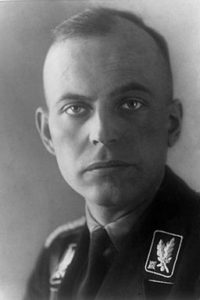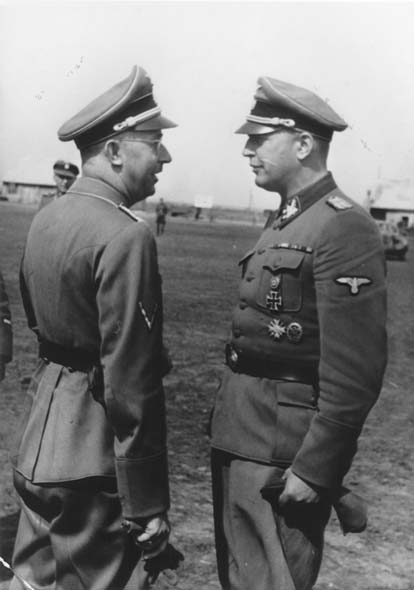The Werwolf Organization
 The Werwolf Organization’s assassination of the Allied appointed Burgermeister of Aachen, Dr. Franz Oppenhoff in March of 1945, is probably the best known and most widely publicized exploit of this hapless band of politically indoctrinated youngsters who hailed for the most part from the ranks of the Hitlerjugend and the Bund Deutscher Maedel. Charles Whiting (aka Leo Kessler) wrote a book named “Werwolf” (recently reprinted) which details this very same mission, called “Unternehmen Karneval” (Operation Carnival). The leader of the assassination team was a veteran of the German Army’s famous “Brandenburg” infiltration-specialist formation, named Herbert Wenzel, who had transferred to Otto Skorzeny’s “SS-Jagdverband Friedenthal” and who, at the time of the operation, held the rank of SS-Untersturmfuhrer (2nd Lieutenant.)  According to a number of sources, the idea for a Werwolf Organization originated in the fall of 1944 at a meeting attended by Reichsfuhrer-SS Himmler, Artur Axmann (HJ Jugendfuhrer), SS-Obergruppenfuhrer Hans-Adolf Prützmann, RSHA chief Ernst Kaltenbrunner, and Waffen-SS Obsturmbannfuhrer Otto Skorzeny. At the meeting in Hohenlychen, Himmler appointed Prützmann as plenipotentiary in charge of the recruiting and training of Werwolfagents from skilled specialists in weapons and communications from among the armed forces and HJ, who would then be trained beneath the aegis of Skorzeny’s SS-Jagdverband (Hunting-teams).  Once trained in sabotage and varying forms of deadly mischief, teams of these Werwolf Kommandos, comprised mostly of HJ volunteers, but commanded by older, battle-experienced hand-picked cadre from the German Army and Waffen-SS, would operate behind the enemy lines as guerrillas, creating deadly mishap amongst the occupying forces, and relaying useful intelligence to a central Armed Forces entity (supposedly in unoccupied territory). Training took place at the Schloss Hulchrath, near the small Rhenish town of Erkelenz. The castle was at the time the HQ of the HSSPF-West, Karl Gutenberger. Here Prützmann set up his Werwolf Staff HQ. The first 200 trainees from the HJ arrived in late November and began their Werwolf training under the guise of W-SS volunteers. They were instructed in small-arms and demolitions skills, radio-communications, map-reading, and survival skills by instructors from Skorzeny’s Jagdverband, experts from the Army, and agents of the SD and Gestapo. They were taught to sabotage vehicles and communications facilities, to poison wells and food supplies -large quantities of arsenic were issued to some squads. When recruits from the HJ or BDM arrived, most had already had preliminary training with rifles, pistols, and panzerfaust. Prützmann’s staff set up other training centers in the Berlin suburbs, and in the so-called area of the Alpine Redoubt in Bavaria. Bestseller No. 1 Last Nazis: SS Werewolf Guerrilla Resistance in Europe 1944-1947 (Revealing History)
Bestseller No. 2 OLD Film Ilsa: She Wolf of The SS (1974) DVD
SaleBestseller No. 3 One Night Ultimate Werewolf – Fun Party Game for Kids & Adults | Engaging Social Deduction |...
Underground bunkers or dens in the Eifel and Bavaria were reserved for Werwolf squads, where food, munitions, and other logistics were to be hidden before Allied units overran them. The Werwolf would operate at night, harassing and sabotaging, and resurface by day and mix with the civil population in their area of operations protected by false passes and papers supplied by the Gestapo. This at least, was the plan. What actually transpired is of course, quite different. Despite the fanciful-mythological Werwolf name, at the outset of this joint SS-HJ undertaking in late 1944, a real spirit of military organization and discipline permeated the training and operational goals of the Werwolf-organization. The Germans knew well from first-hand experience, just how much damage an organized and efficient partisan force could inflict upon an occupying army. The key feature to success in this scenario would, of course, have been a solid base of supply and support – (e.g. an un-occupied Germany). Fantastic dreams of an Alpine Redoubt re-considered these Werwolf squads would have been the long-arm of any logistically viable resistance undertaken by a well-defended Germanpower-base in a mountain retreat, or Alpenfestung. Of course, as events transpired – there was very little action toward the establishment of an Alpine base of resistance by the Germans at this very late date. And so, beyond the one efficacious Operation undertaken by a specifically-trained Werwolf hit-team at Aachen in March of 1945, where one might note that the resources of the OKW (A B-17 of KG-200, the Luftwaffe Special Operations), and the SS-Jagdverband were prominently involved; the later sporadic killings and instances of resistance by so-called Werwolf units, were not intended Werwolf operations as instructed by a higher command, but only isolated acts of last-ditch fanatical resisters, and as such cannot really be accredited to Prützmann’s Werwolf staff. To explain the difference between actual Werwolf organized activity and those incidents attributed to it by the Allied Military authorities is not always an easy task. When Burgomeister Oppenhof was murdered in late March of 1945, Dr. Goebbels and Reichsleiter Martin Bormann (who were both, it might be noted, denizens of the surreal atmosphere of the Fuhrerbunker), saw it as a great propaganda coup and took it upon themselves to proclaim a nationwide uprising of German youth against the Allied aggressor. Goebbels christened the Werwolf-sender or Radio Werwolf with a call to all able-bodied Germans in the Reich and its occupied areas to “strike the enemy” from behind the lines. Radio Werwolf promised death to traitors and a direful fate to the Allied invaders. As a propagandistic ploy, it pandered to a fanatical belief in last-ditch resistance – ironically, it also bolstered a belief in the existence of an Alpine Redoubt among the Allied forces. Bormann’s role in this farce was that as NSDAP Chief of the Gauleiterung, he believed that he commanded the activities of all Werwolf units originating in any Gau of the Reich.  The truth was, in fact, that both Goebbels and Bormann had nothing at all to do with the training, organization, or employment of the Werwolf. As a crony of Himmler, SS-General Prützmann had very little interest in taking orders from either Goebbels or Bormann. So, as the Allied Armies advanced, and eventually overran his Schloss Hulcrath HQ, in April of 1945, he seconded himself to Himmler’s Hohenlychen headquarters in Mecklenberg – at this point, the Werwolf Organization, as a secret behind-the-lines formation, in effect, ceased to exist. Despite the lack of direction from a higher headquarters, examples of spurious Werwolf activity continued well after the cessation of hostilities: The former HJ-Gebeitsfuhrer of Mansfeld, now an SS-Sturmbannfuhrer barely recovered from wounds received in the battle of Kharkov, organized 600 HJ boys into Battle-Group Harz (Kampfgruppe Harz). They collected W-SS veterans from a military hospital, students from a NAPOLA, remaining members of the Luftwaffe-HJ, and boys from a nearby anti-tank-destruction unit. When the Werwolf Radio proclaimed defiance on April 1, they went into action against American troops. Within twenty days, seventy combatants were left, reduced to fifty shortly thereafter. A desperate attempt to ambush an American supplies convoy was unsuccessful. Most of these starving boys were wiped out by air-raids when American patrols could not find them. Heinz Petry, sixteen, and Josef Schomer, seventeen, survived until 5 June, when they were tried as spies by American troops and executed. North of Hamburg, toward the end of April, an entrenched group of Werwolves and their SS commanders refused to surrender to two battalions of the British Eleventh Armored Division. When Admiral Karl Donitz ordered them to lay down their arms on 1 May, they still persisted. A unit of the German 8.Fallshirmjager Division was finally brought in to subdue them. The German Paras found mainly dead bodies scattered around their fortified forest den. On the eastern side of the Elbe, isolated groups of youngsters from the Werwolf center at Berlin-Gatow offered feeble resistance to a swarm of Russian tanks. A few survivors remained hidden in bunkers and were later turned in by angry and hungry civilians, whom the Russian troops regarded by allowing them to plunder the Werwolf food dumps. Donitz finally made a proclamation on 5 May over Radios Copenhagen, Flensburg, and Prague: “The fact that at present an armistice reign means that I must ask every German man and woman to stop any illegal activity in the Werwolf or other such organizations in those territories occupied by the Western Allies because this can only injure our people.” SS-General Hans-Adolf Prützmann, who had previously been HSSPF of Riechskommisariat-Ukraine, and could expect no quarter from the victorious allies, committed suicide in May of 1945. |



